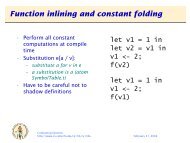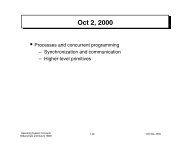semaphores, classic problems
semaphores, classic problems
semaphores, classic problems
You also want an ePaper? Increase the reach of your titles
YUMPU automatically turns print PDFs into web optimized ePapers that Google loves.
Exchange instruction<br />
XCHG—Exchange Register/Memory with Register<br />
INSTRUCTION SET REFERENCE<br />
Opcode Instruction Description<br />
87 /r XCHG r32,r/m32 Exchange doubleword from r/m32 with<br />
Description<br />
This instruction exchanges the contents of the destination (first) and source (second) operands.<br />
The operands can be two general-purpose registers or a register and a memory location. If a<br />
memory operand is referenced, the processor’s locking protocol is automatically implemented<br />
for the duration of the exchange operation, regardless of the presence or absence of the LOCK<br />
prefix or of the value of the IOPL. Refer to the LOCK prefix description in this chapter for more<br />
information on the locking protocol.<br />
This instruction is useful for implementing <strong>semaphores</strong> or similar data structures for process<br />
synchronization. Refer to Section 7.1.2., Bus Locking in Chapter 7, Multiple-Processor<br />
Management of the Intel Architecture Software Developer’s Manual, Volume 3, for more information<br />
on bus locking.<br />
The XCHG instruction can also be used instead of the BSWAP instruction for 16-bit operands.<br />
Operation<br />
TEMP ← DEST<br />
DEST ← SRC<br />
SRC ← TEMP<br />
Flags Affected<br />
None.<br />
Computing Systems<br />
http://www.cs.caltech.edu/cs134/cs134a October 10, 2001





